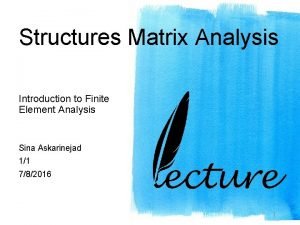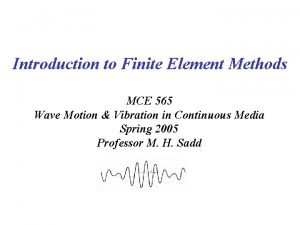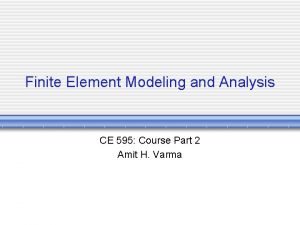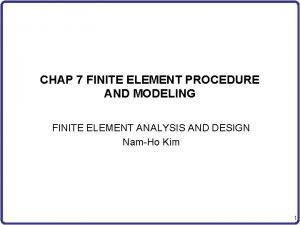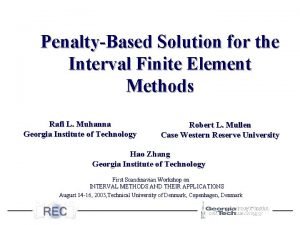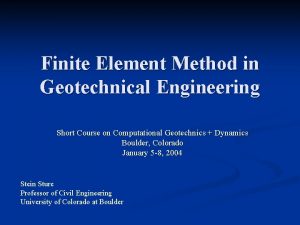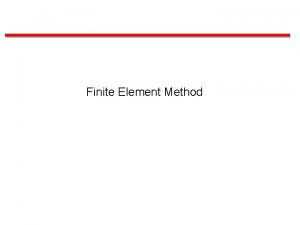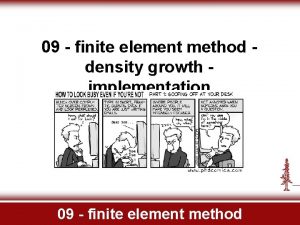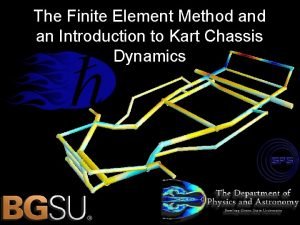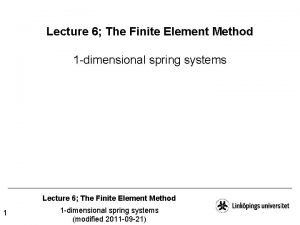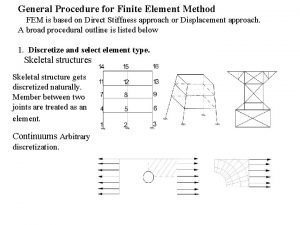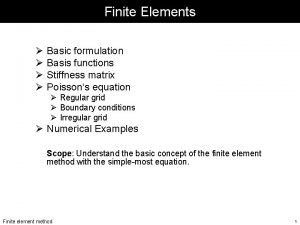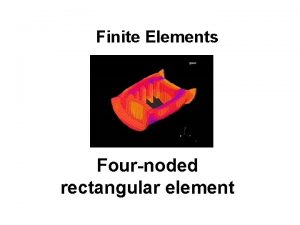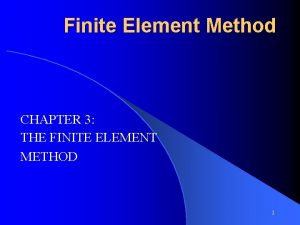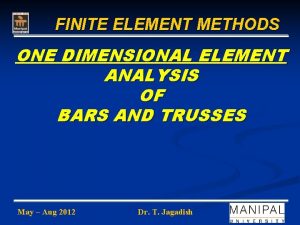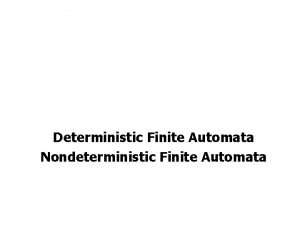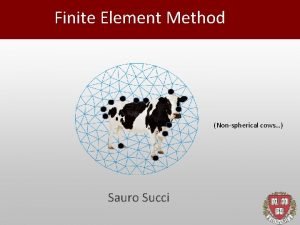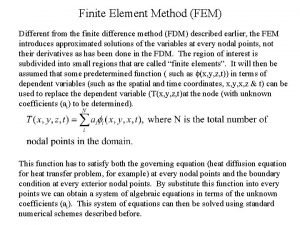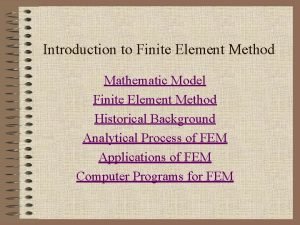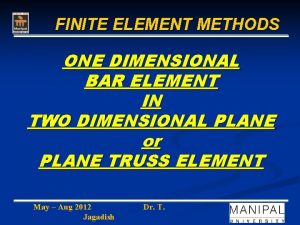Finite Element Analysis Annette Lopez Davila How do




























- Slides: 28

Finite Element Analysis Annette Lopez Davila

How do we know which areas of the car are most likely to be broken when force is applied?

Which chair is more likely to fall?

• The car is one object composed of many other objects such as wheels, windows, doors, a motor, etc. Testing Objects • Each object must work in sync with the other objects for optimal functionality • Car crash tests are conducted for determination of strength of a car when confronted by some force. • Why not simulate it instead?

Finite Element Analysis (FEA) • Finite element analysis is a computerized method for predicting how objects react to forces, temperature changes, fluid flow, and other conditions. • In engineering, it is often used to find weak spots in a design.

• Problem: weight limit of chair The bigger picture • Object is broken down into discreet geometric shapes (finite elements) • Each finite element will have some equation to describe it • These equations are recombined and assembled into one bigger system that we can solve

History • FEA was developed for civil and aeronautical engineering after World War II • Contributions from 1940 s: solve systems of partial differential equations. • 1940 s: • Alexander Hrennikoff • introduced the concept of using a lattice like approach to objects • Richard Courant • divided an object into finite subregions to solve second order elliptic partial differential equations • 50 s and 60 s: Feng Kang • proposed a finite difference method based on variation principle in order to also solve PDEs • 1970 s: Finite Element Method • Although it was first implemented into a software, it was later given a rigorous mathematical basis

Finite Element Method Discretization strategy Solution Algorithm Post Processing Procedure

Mesh • Mesh is a discretization of a domain into small shapes • Discretization: Modeling the body of an object by dividing it into finite elements which are interconnected at two or more nodes and/or boundary lines and surfaces. • Nodes are specific points in the finite element. We calculate the displacement, stress, strain, etc. for each node. For example, we need to find the stress at each particular node.

Let’s pretend we have some object. How many different ways can we make a mesh?

Let’s pretend we have some object. How can we make a mesh?

Choosing our discretization strategy • Shape • Dimension • Type • Size

What happens after we build a mesh?

Materials and Elasticity • Stress: the deforming force per unit of area • Strain: the change in shape of the original object


From Nodes to Linear Algebra: The Stiffness Matrix

Repetition and Reduction E 1 E 2 … En We solve the matrix equations until we are left with one single node solution. Then, we can use our one solution to figure out all the other nodes’ solutions!


Post Processing • Check for Errors within Displacements, Strains, and stresses • Do some concept check calculations by hand • Plot information • Print or sort according to needs • Animate if necessary

But…what about the math? ? FEA: taking a system governed by differential equations and partitioning it into elements that can individually be solved with simple linear equations. With these partitions, we attempt to make a linear approximation as close as possible to the continuous solution.

Boundary Problems • Most engineering applications are represented with differential equations with constraints called boundary conditions • For simple geometries, we use analytical methods such as integration, Laplace transforms, etc. • But how do we handle complex geometries? • We need a numerical method that takes differential equations and boundary constraints and turns them into linear functions

Basic Steps • Establish Strong Formulation of Equations • Obtain weak formulation/weighted residual/variational statement • Choose approximations for unknown functions • Choose basis function • Solve

Establishing a strong formulation with Poisson Equation

Obtain a weak formulation using approximation • It is easier to solve the weaker formula • Start with strong form and multiply by a test function • Integrate the whole equation over the domain

Discretization with Basis Functions • Basis functions are the functions that are multiplied by the coefficients and added to form a solution • Basis function can be linear, quadratic, cubic…as we said before, the shape, amount, and dimension of our elements is chosen in context of the problem!

Solving

Post Processing • Mesh Convergence is one of the most important factors that affect accuracy • In order to verify that the size of our elements is correct, we need to know that increasing the quantity of elements hardly affects the solution. In other words, as the number of elements goes towards infinity, the solution should converge to a specific value. • Convergence can be measured by comparison with experimental results or comparison with other analytical solutions • Errors in Displacement: • Errors in Strains: • Errors in Stresses:

Applications of FEA • Thermo-mechanical, thermochemical, ferroelectric, electromagnetic, fluid structure, flow analysis, structural analysis problems • Civil Engineering and Geology: Innovative Building Materials and Structures, sedimentation/erosion/hydrology, slope stability, seepage of fluids in soils and rocks • Bio-Engineering: Simulation of human organs, testing medical devices and implants • Electronics: Heat analysis in electrical equipment, insulation design analysis • Mechanical engineering: Manufacturing process simulation, automotive design • Meteorology: Climate Predictions, wind prediction, monsoon prediction • Computer Science: Someone has to code the simulations!
 Truss finite element analysis
Truss finite element analysis Finite element analysis
Finite element analysis Phases of finite element method
Phases of finite element method Finite subordinate clauses
Finite subordinate clauses Learning objectives for finite and non finite verbs
Learning objectives for finite and non finite verbs Learning objectives of non finite verbs
Learning objectives of non finite verbs Finite and nonfinite verbs examples
Finite and nonfinite verbs examples Non finite forms of the verb qayda
Non finite forms of the verb qayda Finite element method example
Finite element method example Hourglass modes finite element method
Hourglass modes finite element method Stiffness matrix for cst element
Stiffness matrix for cst element Image preprocessing
Image preprocessing Finite element
Finite element Finite element method in geotechnical engineering
Finite element method in geotechnical engineering Finite element methods
Finite element methods Finite element method
Finite element method Finite element method
Finite element method Finite element method
Finite element method Finite element method
Finite element method Finite element method
Finite element method Alberto dávila zavala
Alberto dávila zavala Abril davila
Abril davila Imagenes de gil gonzalez davila
Imagenes de gil gonzalez davila Tabela bidimensional
Tabela bidimensional Francesca davila
Francesca davila Ashley davila torres
Ashley davila torres Variaveis estatistica
Variaveis estatistica Difference between signal element and data element
Difference between signal element and data element Signal element vs data element
Signal element vs data element
